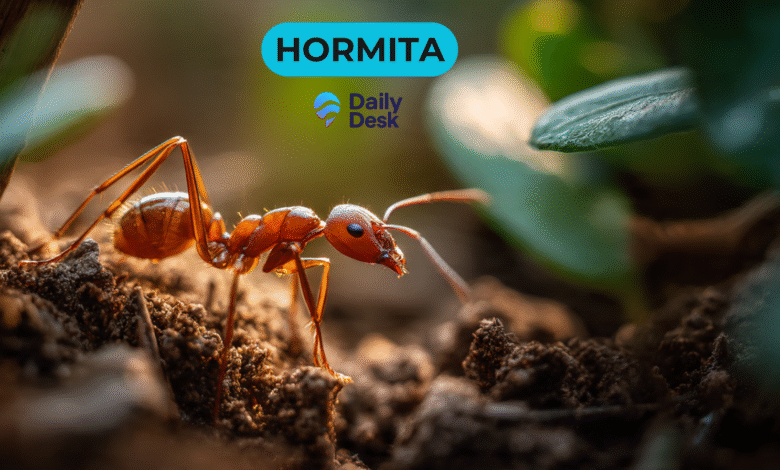Hormita: The Tiny Ant Making a Big Impact on Our Ecosystem

When you think about creatures that shape our environment, ants might not be the first to come to mind. Yet among these industrious insects, the hormita stands out as a remarkable species that plays a crucial role in maintaining ecological balance. This small but mighty ant has captured the attention of scientists and nature enthusiasts alike.
The hormita is more than just another insect crawling beneath our feet. These fascinating creatures work tirelessly to maintain soil health, support plant growth, and contribute to biodiversity. Understanding their importance helps us appreciate the intricate web of life that sustains our planet.
What Exactly Is Hormita?
The hormita is a small ant species that thrives in various ecosystems across different regions. These ants are typically characterized by their diminutive size, ranging from just a few millimeters in length. Despite their tiny stature, they possess remarkable strength and organizational capabilities.
These insects live in highly structured colonies that can contain thousands of individuals. Each hormita colony operates like a well-oiled machine, with different members performing specialized roles. From workers and soldiers to queens and drones, every ant contributes to the colony’s survival and success.
The Physical Characteristics of Hormita
The physical appearance of the hormita makes it easily identifiable to trained observers. These ants typically display a reddish-brown or dark brown coloration, which helps them blend into their natural surroundings. Their bodies are segmented into three distinct parts: the head, thorax, and abdomen.
Their antennae serve as sophisticated sensory organs, allowing them to detect chemical signals and navigate their environment. The hormita uses these antennae to communicate with colony members, locate food sources, and identify potential threats. Their mandibles are powerful tools used for carrying food, excavating tunnels, and defending the colony.
The Complex Social Structure
Colony organization represents one of the most fascinating aspects of hormita behavior. The queen serves as the reproductive center of the colony, laying thousands of eggs throughout her lifetime. Worker ants, which make up the majority of the population, handle various tasks including foraging, nest maintenance, and brood care.
Soldier hormi ta ants defend the colony against intruders using their larger mandibles and aggressive behavior. The division of labor ensures maximum efficiency and survival of the entire colony. Communication occurs through pheromones, touch, and vibrations, creating a sophisticated information network.
Hormita’s Role in Soil Health
One of the most significant contributions of hormita ants lies in their impact on soil quality. As they tunnel underground, these industrious insects create networks of passages that improve soil structure. This tunneling activity enhances soil aeration, allowing oxygen to reach plant roots more effectively.
Water infiltration also improves dramatically in areas with active hormi ta colonies. The channels created by their burrowing allow rainwater to penetrate deeper into the ground, reducing runoff and erosion. This process benefits agriculture and natural ecosystems by promoting healthier plant growth and stronger root systems.
Nutrient Cycling and Decomposition
The hormita plays a vital role in breaking down organic matter and recycling nutrients. These ants collect dead insects, fallen leaves, and other organic materials, bringing them into their nests. As this material decomposes, nutrients are released back into the soil in forms that plants can readily absorb.
This decomposition process accelerates nutrient cycling in ecosystems. The hormita essentially acts as nature’s recycling service, converting waste into valuable resources. Their activities contribute to soil fertility and support robust plant communities that form the foundation of healthy ecosystems.
Impact on Plant Life and Agriculture
Gardeners and farmers benefit greatly from the presence of hormita colonies in their fields. These ants help control pest populations by feeding on harmful insects and their larvae. They also assist in seed dispersal, carrying seeds to new locations where they can germinate and grow.
The hormita’s relationship with plants extends beyond simple pest control. Their tunneling creates pathways that help roots penetrate compacted soil more easily. This improved root growth leads to stronger, healthier plants that are more resistant to drought and disease.
The Foraging Behavior of Hormita
Foraging represents a critical activity for hormita colonies, requiring sophisticated coordination and communication. Scout ants venture out from the nest to locate food sources, laying down pheromone trails for other workers to follow. When a substantial food source is discovered, dozens or even hundreds of workers mobilize to collect it.
The hormi ta exhibits remarkable problem-solving abilities during foraging expeditions. They can navigate complex terrain, overcome obstacles, and adapt their strategies based on environmental conditions. This flexibility ensures the colony maintains a steady food supply throughout different seasons.
Predators and Defense Mechanisms
Despite their small size, hormi ta ants face numerous threats from predators including birds, spiders, and other insects. They have developed various defense mechanisms to protect themselves and their colonies. When threatened, worker ants release alarm pheromones that alert nearby colony members to danger.
Soldier hormita ants rush to defend the colony using their powerful mandibles and sometimes chemical defenses. Some species can spray formic acid at attackers, causing irritation and deterring predators. The collective defense strategy of the colony proves remarkably effective against threats many times larger than individual ants.
Reproduction and Colony Growth
The reproductive cycle of hormita colonies follows a fascinating pattern tied to seasonal changes. During specific times of the year, colonies produce winged males and females called alates. These reproductive individuals participate in nuptial flights, where mating occurs in mid-air.
After mating, male hormita ants die, while fertilized queens shed their wings and search for suitable locations to establish new colonies. A single queen may start her colony with just a handful of eggs, gradually building a population that can number in the thousands. Colony establishment requires tremendous energy and many young queens fail to successfully found new nests.
Environmental Indicators and Research
Scientists increasingly recognize hormita populations as important environmental indicators. Changes in ant abundance or behavior can signal broader ecosystem health issues. Researchers study these insects to understand pollution impacts, climate change effects, and habitat degradation.
The presence of healthy hormita colonies often indicates good soil quality and ecosystem balance. Conservation efforts increasingly consider ant populations when assessing habitat quality and biodiversity. Their sensitivity to environmental changes makes them valuable subjects for ecological monitoring programs.
Hormita in Different Ecosystems
These adaptable insects thrive in various habitats, from tropical rainforests to temperate grasslands. Each ecosystem presents unique challenges that hormita colonies must overcome to survive. Desert-dwelling populations have adapted to extreme temperatures and limited water availability.
Forest hormita populations play crucial roles in decomposing leaf litter and maintaining forest floor health. Grassland colonies contribute to soil structure in prairie ecosystems where their tunneling prevents soil compaction. This adaptability demonstrates the remarkable evolutionary success of these small creatures.
Interaction with Other Species
The hormita forms complex relationships with numerous other organisms in their ecosystems. Some species engage in mutualistic relationships with aphids, protecting them from predators in exchange for sugary honeydew secretions. These interactions create intricate food webs that support biodiversity.
Competition between different ant species, including hormita, shapes community structure and resource distribution. Some hormita colonies engage in territorial disputes with neighboring colonies or different ant species. These interactions influence species distribution patterns and ecosystem dynamics.
Conservation and Future Outlook
Protecting hormita populations becomes increasingly important as habitat loss and environmental changes threaten their survival. Urban development, pesticide use, and climate change all pose significant risks to ant communities. Conservation efforts must consider these small but vital creatures in land management decisions.
The future of hormita populations depends on our commitment to preserving natural habitats and reducing harmful environmental impacts. Simple actions like reducing pesticide use in gardens and maintaining natural areas support these beneficial insects. Understanding their ecological importance motivates better conservation practices.
Practical Tips for Supporting Hormita Populations
Homeowners and gardeners can take simple steps to support hormita colonies in their areas. Avoiding broad-spectrum pesticides protects these beneficial insects while allowing them to control harmful pests naturally. Maintaining areas of undisturbed soil provides nesting sites for colonies to establish and thrive.
Creating diverse plantings attracts the hormita and other beneficial insects to your garden. Native plants particularly support local ant populations adapted to regional conditions. Leaving some leaf litter and organic debris provides food sources and nesting materials.
Conclusion
The hormita represents far more than a tiny insect beneath our notice. These remarkable creatures serve as ecosystem engineers, improving soil health, cycling nutrients, and supporting plant communities. Their complex social structures and adaptive behaviors demonstrate nature’s incredible sophistication.
Recognizing the importance of hormita populations encourages better environmental stewardship and conservation practices. By protecting these small creatures, we safeguard the health of entire ecosystems that depend on their tireless work. The next time you see ants marching across your path, remember the vital role they play in maintaining the natural world we all depend on.
Read Also: Liisbettsis Runnak: The Hidden Innovation Transforming Modern Creativity





